DFI X48 LT T2R: Floats like a Butterfly…
by Rajinder Gill on April 28, 2008 4:00 AM EST- Posted in
- Motherboards
Board Layout and Features
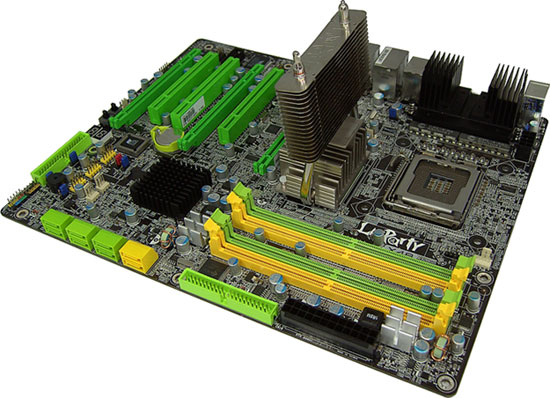 |
As with other LANParty boards, DFI's near-flawless layout continues. Cooling on the LT version is probably the best overall solution rather than opting for the upcoming UT version of this board, which connects all three heatsinks with a heatpipe. Having independent heatsinks allows users to replace a single section with more exotic cooling should they so desire, although we found that the stock Northbridge cooler (supplied by Thermalright) is very good. Teamed up with suitable airflow the Thermalright NB cooler is capable of dissipating large amounts of heat. Although we still recommend that active cooling is used on both the Northbridge and PWM area when overclocking this board.
Large CPU coolers like the Thermalright Ultra-120 must be mounted in horizontal orientation to provide clearance for the stock Northbridge cooler. This is not really a bad thing - using two 120mm fans in push-pull on the Thermalright 120 cooler will also cool the Northbridge heatsink very effectively. Using this combination of coolers with two 120mm fans in push-pull kept our full-load Northbridge temperatures under 42C even while using around 1.6VMCH.
We must stress that cooling the PWM heatsink is a little tricky when the board is mounted in a case. We used a small fan in combination with a couple of small machine screws to attach the fan to the PWM heatsink. We recommend that users monitor PWM load temperatures via the supplied ITE monitoring software and try to ensure that PWM temperatures remain around 50C under full load.
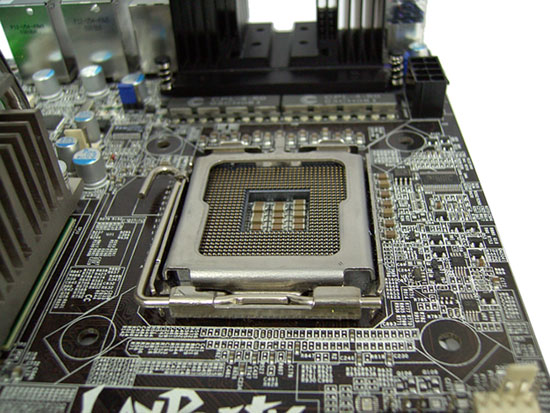 |
All of DFI's performance oriented motherboards over the past year have featured 8-phase Volterra digital PWM circuitry to supply CPU power, and there's no change here. However, we would like to see the inclusion of a heatsink backplate on future DFI boards to ensure that the small Volterra MOSFETs do not lose contact with the heatsink when the motherboard bows under pressure from some of the higher torque mounting systems used on CPU coolers. As the Volterra MOSFETs are so small, any loss of contact between the FET and heatsink during a heavy transient load will result either in board shutdown or something catastrophic.
Even though we did not experience these problems ourselves, we feel the current implementation certainly has room for improvement. The EPS 12V power connector sits just behind the PS/2 ports at the top corner of the board, while the CPU fan header is situated adjacent to the first DIMM slot. There are six fan headers on the board - three of which are OS controllable via the supplied ITE monitoring software.
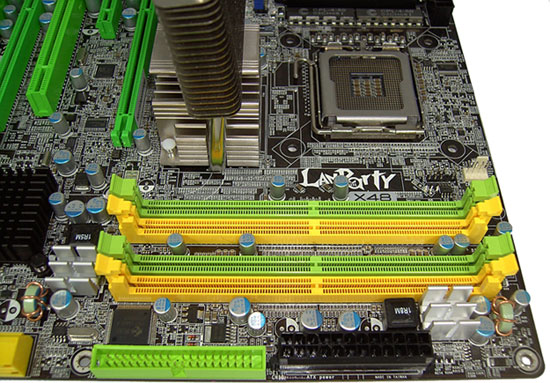 |
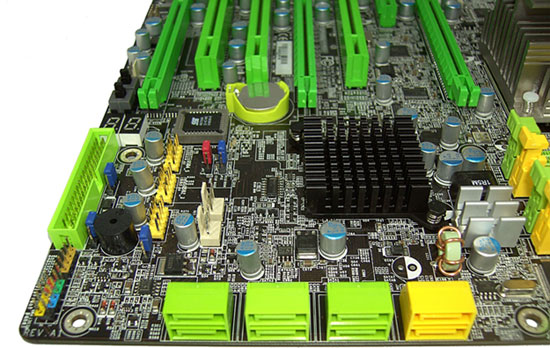 |
The overclocking friendly layout continues to an easily accessible CMOS battery, and onboard power and reset switches featuring EZ CMOS clear and of course the LED POST Code display. The floppy drive connector sits at the lower edge of the board to the right of the POST Code display. The six Intel ICH9R SATA ports are located at the lower right edge of the board, facing to the right making connector insertion a tad awkward at once the board is mounted in a case. There are also two JMicron JMB363 SATA ports situated above the Intel SATA ports.
The memory slot connectors are situated almost in line with the primary PCI Express connector; large graphics cards such as the 8800 GTX may have to be removed when swapping out memory modules. The 24-pin ATX connector is placed to the right of the slots and does not hinder the use of the IDE connector below it.
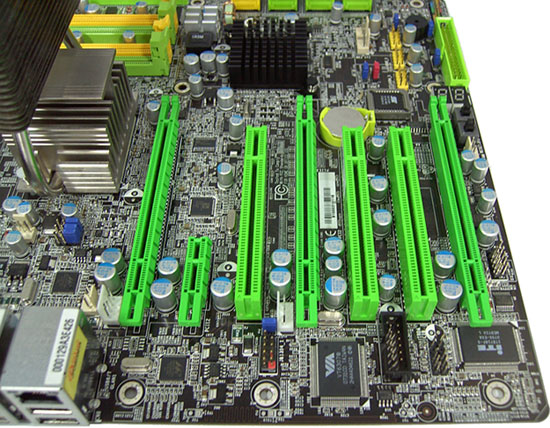 |
The expansion slot layout is comprised of three PCI Express x16 full length slots (two x16 bandwidth and one x4 bandwidth slot), one PCIEx1 slot, and three PCI slots. The supplied Bernstein Audio module features the Realtek ALC885 8-channel High Definition Audio CODEC and has its dedicated connector placed between the PCI slots, rendering one of the PCI slots inactive if the module is used. There are three onboard USB connectors for an additional six USB ports, a connector for an external COM port, one IrDA connector, one CIR connector, and a connector for the second IEEE-1394 port.
 |
The rear I/O options include six USB ports, an IEEE-1394a port, two Gigabit LAN ports with teaming options, and finally the standard PS/2 keyboard and mouse ports.










24 Comments
View All Comments
orangeblue - Friday, June 13, 2008 - link
hi,can anybody tell me if the ocz flex 9200 4gb-kit(2x2048) workz too instead the four 1024 plz.
Zoomer - Saturday, May 3, 2008 - link
I miss the analysis of other features than just plain memory latency.Max fsb overclock, max mem overclock, etc?
Running the board at 400fsb seems boring - lots of P965 boards can best that. Tons of people don't buy these multiplier unlocked chips.
Rajinder Gill - Sunday, May 4, 2008 - link
Hi,Dual core 45nm's top out at around 510-515FSB using air cooling. Most of the quad CPU info is in the review.
We are looking at perhaps adding some more content tomorrow. Mainly 2x2GB and 4X1GB maxmimum stable overclocks and best operating points - using air cooling.
When Using 45nm dual core CPU's X48/X38 chipsets are really only 'good' to around 500FSB tops for 24/7, after this VMCH requirements and total stability with low tRD becomes futile rather quickly. SOme of the DDR3 boards are a little better in this regard, though this overhaed always comes at a high voltage price when used with a suitably high CPU multiplier.
65nm CPU's in dual core form may cruise upto 550fsb with some work, perhaps a 67% GTL table will help for that. Many of the benches in the review were run at 8x500FSB just to reflect the maximum 24/7 somebody is likely to be able to achieve and/or use consistently. FSB values over this are prone to failure in applications like PC Mark Vantage or 3D in some instance (even with lots of GTL work). Our E8500 processor managed 510FSB with 4X1GB maximum stable on this board, while using 2x1GB memory allowed me to boot at a around 520FSB - though this was far from being called stable.
regards
Raja
Zoomer - Wednesday, May 7, 2008 - link
Thanks for taking the time to respond.Unfortunately, I have not been keeping up with the latest tweaks on the best boards. Thanks for the detail, though. :)
amalinov - Friday, May 2, 2008 - link
Am I imaging things or something fishy is going on here?The board has 2 PCIe 2.0 x16 slots - from the X48 MCH. OK.
The board has the following PCIe devices connected to the ICH9R:
1. PCIe x1 slot
2. PCIe x1 JMB363 SATA/PATA controller
3. PCIe x1 Marvell 88E8052 Gigabit Ethernet controller
4. PCIe x1 Marvell 88E8053 Gigabit Ethernet controller
5. PCIe x4 slot (physical x16)
IMHO in this situation the x4 slot can be utilized as x4 only if at least 2 of the PCIe x1 devices are disabled? (if so, then wich exactly?) But this is not mentioned anywhere - neighter in the review, nor in the official DFI specifications or manual. Also, in the manual there is no BIOS settings description section - so I can't find what does the "PCIE Slot Config - 1X 1X" option stand for? (I assume for putting the x4/x16 slot in x1/x16 mode when the other devices are not disabled?)
n7 - Tuesday, April 29, 2008 - link
Great stuff.I have one concern though.
What are you using to test stability for 8 GB?
I have found that what people like to consider "stable" is only stable because of the use of applications like P95, Everest, OCCT, & Memtest86+, which don't tend to really stress 4+ GB RAM & the Northbridge to the same extent as multiple instances of HCI Memtest or as LinPack.
Just curious is all.
Rajinder Gill - Monday, May 5, 2008 - link
HCI memtest seems the way to go for me for memory NBGTL related stuff.For CPU core testing Prime/PC Mark Vantage (Blu-Ray test).regards
Raja
aldy402 - Tuesday, April 29, 2008 - link
great review RajinderIt was very in-depth and well written. A big chunk of the memory portion seemed to focus on micron D9 chips. I have the 4gb Gskill(powerchip ICs) and would really like to see a write up on this board involving "other ICs" and maby a guide with 65nm quads.
also have you tested the performance differential between the intel and jmicron sata ports?
well done
-Aldy
Rajinder Gill - Tuesday, April 29, 2008 - link
HI Andy,Although the guide says Micron I did add a comment on TRFC and double density modules. tRAS adn tRFC are the 2 tiimings that need to be changed for the most part. The boards will hold upto 450FSB and a dual core 45nm 'stable' with most of the chipset registers set to fast/more aggressive. Comments are already in the guide for 65nm CPU's pertaining to leaving the GTL controls at defaults - nothing more is really needed tbh..
regards
Raja
coolbluewater - Tuesday, April 29, 2008 - link
Replacing two of the six USB ports ith two eSata ports would seem to make sense. Not sure why they didn't do this on a board in this price range.